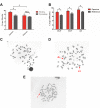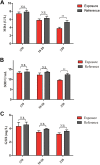Assessment of Genomic Instability in Medical Workers Exposed to Chronic Low-Dose X-Rays in Northern China
- PMID: 31819742
- PMCID: PMC6883363
- DOI: 10.1177/1559325819891378
Assessment of Genomic Instability in Medical Workers Exposed to Chronic Low-Dose X-Rays in Northern China
Abstract
The increasing use of ionizing radiation (IR) in medical diagnosis and treatment has caused considerable concern regarding the effects of occupational exposure on human health. Despite this concern, little information is available regarding possible effects and the mechanism behind chronic low-dose irradiation. The present study assessed potential genomic damage in workers occupationally exposed to low-dose X-rays. A variety of analyses were conducted, including assessing the level of DNA damage and chromosomal aberrations (CA) as well as cytokinesis-block micronucleus (CBMN) assay, gene expression profiling, and antioxidant level determination. Here, we report that the level of DNA damage, CA, and CBMN were all significantly increased. Moreover, the gene expression and antioxidant activities were changed in the peripheral blood of men exposed to low-dose X-rays. Collectively, our findings indicated a strong correlation between genomic instability and duration of low-dose IR exposure. Our data also revealed the DNA damage repair and antioxidative mechanisms which could result in the observed genomic instability in health-care workers exposed to chronic low-dose IR.
Keywords: DNA damage; antioxidants; biomarker; genomic instability; low-dose ionizing radiation.
© The Author(s) 2019.
Conflict of interest statement
Declaration of Conflicting Interests: The author(s) declared no potential conflicts of interest with respect to the research, authorship, and/or publication of this article.
Figures





References
-
- Ciraj-Bjelac O, Rehani MM, Sim KH, Liew HB, Vano E, Kleiman NJ. Risk for radiation-induced cataract for staff in interventional cardiology: is there reason for concern? Catheter Cardiovasc Interv. 2010;76(6): 826–834. - PubMed
-
- Visweswaran S, Joseph S, S VH, O A, Jose MT, Perumal V. DNA damage and gene expression changes in patients exposed to low-dose X-radiation during neuro-interventional radiology procedures. Mutat Res. 2019;844:54–61. - PubMed
-
- Basheerudeen S, Kanagaraj K, Jose MT, et al. Entrance surface dose and induced DNA damage in blood lymphocytes of patients exposed to low-dose and low-dose-rate X-irradiation during diagnostic and therapeutic interventional radiology procedures. Mutat Res. 2017;818:1–6. - PubMed
LinkOut - more resources
Full Text Sources

